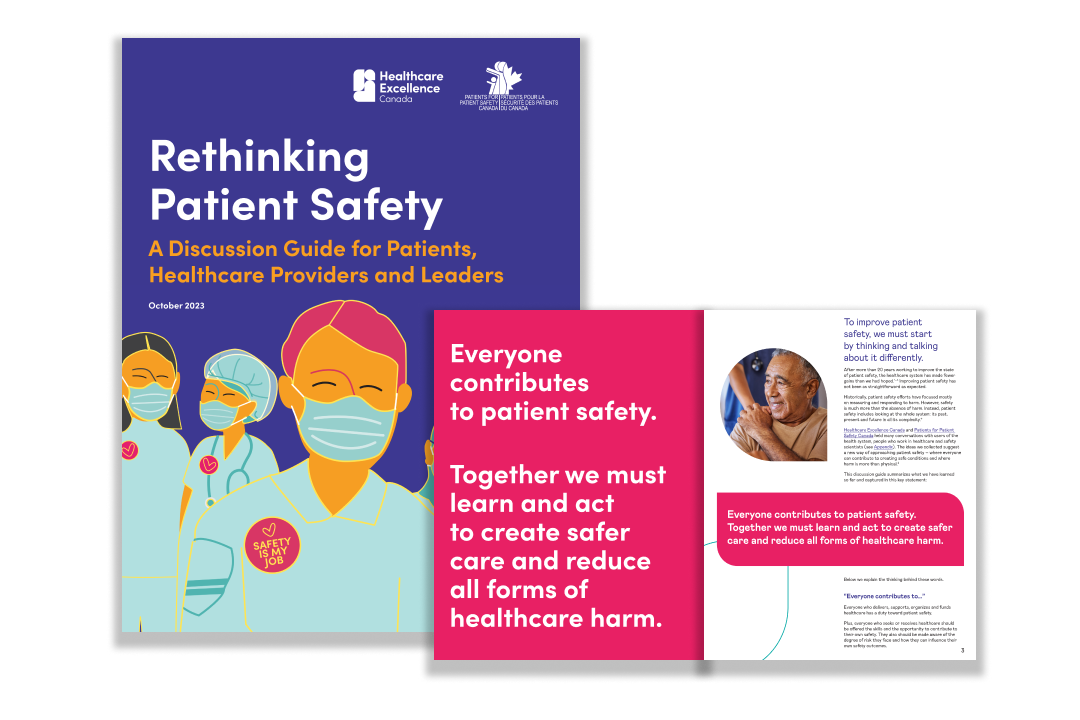
Rethinking Patient Safety Discussion Guide
This discussion guide explores a new approach to patient safety where everyone contributes to safer care, and the vital roles of cultural and psychological safety are emphasized.
Historically, patient safety efforts have focused mostly on measuring and responding to harm. However, safety is much more than the absence of harm. It requires us to look at the whole system to understand how to create lasting conditions and culture for safer care.
In 2022 and 2023, Healthcare Excellence Canada and Patients for Patient Safety Canada held conversations with healthcare workers and safety scientists. Their reflections guided the development of Rethinking Patient Safety – a new statement and discussion guide that offers a way of approaching patient safety where everyone can contribute to creating safer conditions and where all forms of healthcare harm are acknowledged, including those related to physical, psychological and cultural safety.
What’s inside
This short guide is built around HEC’s new statement on patient safety: “Everyone contributes to patient safety. Together we must learn and act to create safer care and reduce all forms of healthcare harm.”
An explanation of the different components of this statement are provided, supported by discussion questions designed to help you and your team reflect on your efforts to improve patient safety, such as:
- Who do you speak to when you have a safety concern or compliment? How can you create safe spaces for people to talk about safety?
- How have you approached safety in the past? How might you approach it differently now?
- How can you encourage the sharing of power among patients, caregivers, communities, providers, staff and leaders to enhance patient safety?
- How can action on patient safety help reduce health inequities? How can action on health inequities help improve patient safety?
Why it matters
To improve patient safety, we must start by thinking and talking about it differently.
When it comes to keeping patients safe, we need to think about all the ways they might be harmed. In the past, we mostly focused on things like falls and infections in hospitals because they are easier to measure. But there are other kinds of harm we often forget about, like getting too much or too little treatment, getting the wrong treatment, or receiving treatment too late. Other harms include racism, discrimination based on abilities, age, sex, gender, religion and social class, as well as discrimination related to body size and mental health.
Patient safety is a shared responsibility that goes beyond the roles of managers, quality and patient safety leaders, and practitioners; it involves everyone, including patients, families and care partners. Recognizing how safety is interconnected for all stakeholders, individuals should actively engage by voicing concerns, participating in safety discussions and contributing to solutions. Rethinking Patient Safety highlights the importance of moving beyond just looking at past harm and adopting a proactive approach. Safety isn't just about avoiding harm; it requires ongoing efforts to establish safe conditions through every decision and action, emphasizing that everyone has a role in actively shaping and maintaining a safe healthcare environment.
Authors
Rachel Gilbert, Maaike Asselbergs, Donna Davis, Anne MacLaurin, Ioana Popescu, Carol Fancott.
Advisors
Wendy Nicklin, G. Ross Baker, Dr. Alika Lafontaine
Contributors
Carla St. Croix, Andrea Piché, Denise McCuaig, Kim Mumford, Hailey Riendeau, James Rebello, Beatrice Onwuka, Jennifer Schipper at Arc Communications and Shoshanna Hahn-Goldberg and team at OpenLab.
We would like to thank all Healthcare Excellence Canada staff and leadership, HEC community of patient partners including Patients for Patient Safety Canada and all the participants in the engagement activities who provided invaluable insight into this process.
PowerPoint presentation
Share the new approach to safer care with a presentation deck you can make your own.